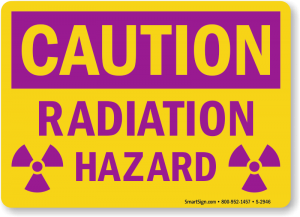
Ionizing radiation is everywhere in low doses. The average citizen receives 4 microsieverts (mSv) of radiation exposure per year through various sources, ranging from airline flights to medical x-rays to eating bananas. For comparison, 50 mSv of radiation exposure is the one-year limit for radiation workers; 100 mSv is the lowest one-year dose linked to heightened cancer risk, 400 mSv causes symptoms of radiation poisoning, and 2000 mSv can be fatal.
In the workplace, the most common exposures are in the healthcare and veterinary industries, from sources like X-ray machines and from nuclear medicine. Ionizing radiation can cause cancer, birth defects and radiation sickness. Most radiation controls are site-specific. But in the case of a radiological emergency, rely on (a) time; (b) distance; and (c) shielding. In short, limit the amount of time you’re exposed to radiation, get away from the source of radiation, and use proper shielding to avoid unnecessary exposure. Lead, concrete, and water all absorb ionizing radiation in various amounts, which is why patients wear lead aprons at their doctor’s office during X-rays.